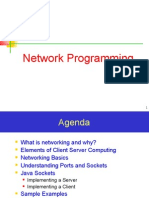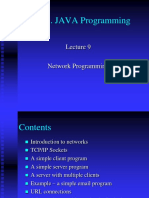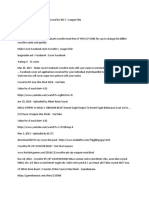0 ratings0% found this document useful (0 votes)
257 viewsBuilding A Simple Web Server
This document describes a simple Java-based web server that handles HTTP requests. The server accepts TCP connections on port 6789. It reads the HTTP request line to extract the requested file name. It then opens the requested file, reads it into a byte array, generates the HTTP response header, and writes the header and file bytes to the client. The header includes the status line, content type based on file extension, and content length. This provides a basic example of how a web server can accept HTTP requests and return requested files over TCP.
Uploaded by
Anh WeasleyCopyright
© © All Rights Reserved
We take content rights seriously. If you suspect this is your content, claim it here.
Available Formats
Download as PDF, TXT or read online on Scribd
0 ratings0% found this document useful (0 votes)
257 viewsBuilding A Simple Web Server
This document describes a simple Java-based web server that handles HTTP requests. The server accepts TCP connections on port 6789. It reads the HTTP request line to extract the requested file name. It then opens the requested file, reads it into a byte array, generates the HTTP response header, and writes the header and file bytes to the client. The header includes the status line, content type based on file extension, and content length. This provides a basic example of how a web server can accept HTTP requests and return requested files over TCP.
Uploaded by
Anh WeasleyCopyright
© © All Rights Reserved
We take content rights seriously. If you suspect this is your content, claim it here.
Available Formats
Download as PDF, TXT or read online on Scribd
You are on page 1/ 6
connection requests, as done in TCPServer.java.
If multiple clients access this
application, they will all send their packets into this single door, serverSocket.
String sentence = new String(receivePacket.getData());
InetAddress IPAddress = receivePacket.getAddress();
int port = receivePacket.getPort();
The above three lines unravel the packet that arrives from the client. The first of the
three lines extracts the data from the packet and places the data in the String
sentence; it has an analogous line in UDPClient. The second line extracts the
IP address; the third line extracts the client port number, which is chosen by the
client and is different from the server port number 9876. (We will discuss client port
numbers in some detail in the next chapter.) It is necessary for the server to obtain
the address (IP address and port number) of the client, so that it can send the capital-
ized sentence back to the client.
That completes our analysis of the UDP program pair. To test the application,
you install and compile UDPClient.java in one host and UDPServer.java
in another host. (Be sure to include the proper hostname of the server in UDP
Client.java.) Then execute the two programs on their respective hosts. Unlike
with TCP, you can first execute the client side and then the server side. This is
because the client process does not attempt to initiate a connection with the server
when you execute the client program. Once you have executed the client and server
programs, you may use the application by typing a line at the client.
Building a Simple Web Server
Now that we have studied HTTP in some detail and have learned how to write
client/server applications in Java, let us combine this new knowledge and build a
simple Web server in Java. We will see that the task is remarkably easy.
2.9.1 Web Server Functions
Our goal is to build a server that does the following:
Handles only one HTTP request
Accepts and parses the HTTP request
Gets the requested file from the servers file system
Creates an HTTP response message consisting of the requested file preceded by
header lines
Sends the response directly to the client
164 CHAPTER 2 APPLICATION LAYER
2.9
CH02_073-182.qxd 4/16/04 2:12 PM Page 164
Lets try to make the code as simple as possible in order to shed some light on the
networking issues. The code that we present will be far from bulletproof! For exam-
ple, lets not worry about handling exceptions. Lets also assume that the client
requests an object that isfor surein the servers file system.
WebServer.java
Here is the code for a simple Web server:
2.9 BUILDING A SIMPLE WEB SERVER 165
import java.io.*;
import java.net.*;
import java.util.*;
class WebServer {
public static void main(String argv[]) throws Exception {
String requestMessageLine;
String fileName;
ServerSocket listenSocket = new ServerSocket(6789);
Socket connectionSocket = listenSocket.accept();
BufferedReader inFromClient =
new BufferedReader(new InputStreamReader(
connectionSocket.getInputStream()));
DataOutputStream outToClient =
new DataOutputStream(
connectionSocket.getOutputStream());
requestMessageLine = inFromClient.readLine();
StringTokenizer tokenizedLine =
new StringTokenizer(requestMessageLine);
if (tokenizedLine.nextToken().equals(GET)){
fileName = tokenizedLine.nextToken();
if (fileName.startsWith(/) == true )
fileName = fileName.substring(1);
File file = new File(fileName);
int numOfBytes = (int) file.length();
FileInputStream inFile = new FileInputStream (
fileName);
byte[] fileInBytes = new byte[numOfBytes];
inFile.read(fileInBytes);
outToClient.writeBytes(
HTTP/1.0 200 Document Follows\r\n);
if (fileName.endsWith(.jpg))
outToClient.writeBytes(Content-Type:
image/jpeg\r\n);
if (fileName.endsWith(.gif))
CH02_073-182.qxd 4/16/04 2:12 PM Page 165
Let us now take a look at the code. The first half of the program is almost iden-
tical to TCPServer.java. As with TCPServer.java, we import the
java.io and java.net packages. In addition to these two packages we also
import the java.util package, which contains the StringTokenizer class,
which is used for parsing HTTP request messages. Looking now at the lines within
the class WebServer, we define two string objects:
String requestMessageLine;
String fileName;
The object requestMessageLine is a string that will contain the first line in the
HTTP request message. The object fileName is a string that will contain the file
name of the requested file. The next set of commands is identical to the correspon-
ding set of commands in TCPServer.java.
ServerSocket listenSocket = new ServerSocket(6789);
Socket connectionSocket = listenSocket.accept();
BufferedReader inFromClient =
new BufferedReader(new InputStreamReader
(connectionSocket.getInputStream()));
DataOutputStream outToClient =
new DataOutputStream(connectionSocket.
getOutputStream());
Two socket-like objects are created. The first of these objects is listenSocket,
which is of type ServerSocket. The object listenSocket is created by the
server program before it receives a request for a TCP connection from a client. It lis-
tens at port 6789 and waits for a request from some client to establish a TCP con-
nection. When a request for a connection arrives, the accept() method of
listenSocket creates a new object, connectionSocket, of type Socket.
166 CHAPTER 2 APPLICATION LAYER
outToClient.writeBytes(Content-Type:
image/gif\r\n);
outToClient.writeBytes(Content-Length: +
numOfBytes + \r\n);
outToClient.writeBytes(\r\n);
outToClient.write(fileInBytes, 0, numOfBytes);
connectionSocket.close();
}
else System.out.println(Bad Request Message);
}
}
CH02_073-182.qxd 4/16/04 2:12 PM Page 166
Next, two streams are created: the BufferedReader inFromClient and the
DataOutputStream outToClient. The HTTP request message comes from
the network, through connectionSocket and into inFromClient; the HTTP
response message goes into outToClient, through connectionSocket and
into the network. The remaining portion of the code differs significantly from
TCPServer.java.
requestMessageLine = inFromClient.readLine();
The above command reads the first line of the HTTP request message. This line is
supposed to be of the form
GET file_name HTTP/1.0
Our server must now parse the line to extract the file name.
StringTokenizer tokenizedLine =
new StringTokenizer(requestMessageLine);
if (tokenizedLine.nextToken().equals(GET)){
fileName = tokenizedLine.nextToken();
if (fileName.startsWith(/) == true )
fileName = fileName.substring(1);
The above commands parse the first line of the request message to obtain the
requested file name. The object tokenizedLine can be thought of as the origi-
nal request line with each of the words GET, file_name, and HTTP/1.0
placed in a separate placeholder called a token. The server knows from the HTTP
RFC that the file name for the requested file is contained in the token that follows
the token containing GET. This file name is put in a string called fileName. The
purpose of the last if statement in the above code is to remove the slash that may
precede the file name.
FileInputStream inFile = new FileInputStream (fileName);
The above command attaches a stream, inFile, to the file fileName.
byte[] fileInBytes = new byte[numOfBytes];
inFile.read(fileInBytes);
These commands determine the size of the file and construct an array of bytes of
that size. The name of the array is fileInBytes. The last command reads from
the stream inFile to the byte array fileInBytes. The program must convert
to bytes because the output stream outToClient may only be fed with bytes.
2.9 BUILDING A SIMPLE WEB SERVER 167
CH02_073-182.qxd 4/16/04 2:12 PM Page 167
Now we are ready to construct the HTTP response message. To this end we
must first send the HTTP response header lines into the DataOutputStream
outToClient:
outToClient.writeBytes(HTTP/1.0 200 Document
Follows\r\n);
if (fileName.endsWith(.jpg))
outToClient.writeBytes(Content-Type:
image/jpeg\r\n);
if (fileName.endsWith(.gif))
outToClient.writeBytes(Content-Type:
image/gif\r\n);
outToClient.writeBytes(Content-Length: + numOfBytes +
\r\n);
outToClient.writeBytes(\r\n)
The above set of commands is particularly interesting. These commands prepare the
header lines for the HTTP response message and send the header lines to the TCP
send buffer. The first command sends the mandatory status line HTTP/1.0 200
Document Follows, followed by a carriage return and a line feed. The next two
command lines prepare a single content-type header line. If the server is to transfer
a GIF image, then the server prepares the header line Content-Type:
image/gif. If, on the other hand, the server is to transfer a JPEG image, then the
server prepares the header line Content-Type: image/jpeg. (In this simple
Web server, no content line is sent if the object is neither a GIF nor a JPEG image.)
The server then prepares and sends a content-length header line and a mandatory
blank line to precede the object itself that is to be sent. We now must send the file
FileName into the DataOutputStream outToClient.
We can now send the requested file:
outToClient.write(fileInBytes, 0, numOfBytes);
The above command sends the requested file, fileInBytes, to the TCP send
buffer. TCP will concatenate the file, fileInBytes, to the header lines just cre-
ated, segment the concatenation if necessary, and send the TCP segments to the
client. After serving one request for one file, the server performs some housekeep-
ing by closing the socket connectionSocket:
connectionSocket.close();
To test this Web server, install it on a host. Also put some files in the host. Then
use a browser running on any machine to request a file from the server. When you
168 CHAPTER 2 APPLICATION LAYER
CH02_073-182.qxd 4/16/04 2:12 PM Page 168
request a file, you will need to use the port number that you include in the server
code (for example, 6789). So if your server is located at somehost.some-
where.edu, the file is somefile.html, and the port number is 6789, then the
browser should request the following:
http://somehost.somewhere.edu:6789/somefile.html
2.10 Summary
In this chapter weve studied the conceptual and the implementation aspects of net-
work applications. Weve learned about the ubiquitous client-server architecture
adopted by Internet applications and seen its use in the HTTP, FTP, SMTP, POP3,
and DNS protocols. Weve studied these important application-level protocols, their
associated applications (the Web, file transfer, e-mail, and DNS) in some detail.
Weve also learned about the increasingly prevalent P2P architecture and seen its
use in P2P file sharing. Weve examined how the socket API can be used to build
network applications. Weve walked through the use of sockets for connection-ori-
ented (TCP) and connectionless (UDP) end-to-end transport services, and also built
a simple Web server using sockets. The first step in our journey down the layered
network architecture is complete!
At the very beginning of this book, in Section 1.1, we gave a rather vague,
bare-bones definition of a protocol: the format and the order of messages
exchanged between two or more communicating entities, as well as the actions
taken on the transmission and/or receipt of a message or other event. The mate-
rial in this chapter, and in particular our detailed study of the HTTP, FTP, SMTP,
POP3, and DNS protocols, has now added considerable substance to this defini-
tion. Protocols are a key concept in networking; our study of applications proto-
cols has now given us the opportunity to develop a more intuitive feel for what
protocols are all about.
In Section 2.1 we described the service models that TCP and UDP offer to
applications that invoke them. We took an even closer look at these service models
when we developed simple applications that run over TCP and UDP in Sections 2.7
through 2.9. However, we have said little about how TCP and UDP provide these
service models. For example, we have said little about how TCP provides a reliable
data transfer service to its applications. In the next chapter well take a careful look
at not only the what, but also the how and why of transport protocols.
Equipped with knowledge about Internet application structure and application-
level protocols, were now ready to head further down the protocol stack and exam-
ine the transport layer in Chapter 3.
2.10 SUMMARY 169
CH02_073-182.qxd 4/16/04 2:12 PM Page 169
You might also like
- Unit-2 Networking Lecture-10: Introduction To Networking:: Connecting To A ServerNo ratings yetUnit-2 Networking Lecture-10: Introduction To Networking:: Connecting To A Server20 pages
- Agenda: Elements of Client Server Computing Networking Basics Understanding Ports and Sockets Java SocketsNo ratings yetAgenda: Elements of Client Server Computing Networking Basics Understanding Ports and Sockets Java Sockets27 pages
- How The Communication Occurs?: PC ClientNo ratings yetHow The Communication Occurs?: PC Client20 pages
- JAVA Programming: Kuldeep Kumar Yogi Banasthali UniversityNo ratings yetJAVA Programming: Kuldeep Kumar Yogi Banasthali University23 pages
- Application Layer: A Note On The Use of These PPT SlidesNo ratings yetApplication Layer: A Note On The Use of These PPT Slides76 pages
- Network Programming and Java Sockets: Dept. of Computing and Information Systems University of Melbourne, Australia orNo ratings yetNetwork Programming and Java Sockets: Dept. of Computing and Information Systems University of Melbourne, Australia or28 pages
- Network Programming and Java Sockets: Professor Rajkumar Buyya100% (2)Network Programming and Java Sockets: Professor Rajkumar Buyya28 pages
- Unit-2 Networking: By: Neha Aggarwal (Senior Lecturer CSE/IT)No ratings yetUnit-2 Networking: By: Neha Aggarwal (Senior Lecturer CSE/IT)53 pages
- Network Programming and Java Sockets Agenda: Internet Applications Serving Local and Remote UsersNo ratings yetNetwork Programming and Java Sockets Agenda: Internet Applications Serving Local and Remote Users5 pages
- Lesson 05: Simple Web Server Using Java: Learning OutcomeNo ratings yetLesson 05: Simple Web Server Using Java: Learning Outcome8 pages
- Socket Programming: Learn How To Build Client/server Applications That Communicate Using SocketsNo ratings yetSocket Programming: Learn How To Build Client/server Applications That Communicate Using Sockets17 pages
- chapter8 Network Programming with socketNo ratings yetchapter8 Network Programming with socket97 pages
- Networking With Android: M.Sc. Bui Tan Loc100% (1)Networking With Android: M.Sc. Bui Tan Loc27 pages
- CSCI2020U - Week 7 - Network Programming - Sockets, TCP, UDPNo ratings yetCSCI2020U - Week 7 - Network Programming - Sockets, TCP, UDP57 pages
- Communication Enhancement Using Socket Programming: Prashant SoniNo ratings yetCommunication Enhancement Using Socket Programming: Prashant Soni5 pages
- Advanced Java Programming: Unit Two: Servers and ServletsNo ratings yetAdvanced Java Programming: Unit Two: Servers and Servlets52 pages
- Unit-Viii: Generic Connection FrameworkNo ratings yetUnit-Viii: Generic Connection Framework23 pages
- Network Programming with Go: Code Secure and Reliable Network Services from ScratchFrom EverandNetwork Programming with Go: Code Secure and Reliable Network Services from ScratchNo ratings yet
- Topic: - "LAMP Application": Chapter ReviewNo ratings yetTopic: - "LAMP Application": Chapter Review4 pages
- Guide To Creating A Bar Chart in Microsoft Word: Step1No ratings yetGuide To Creating A Bar Chart in Microsoft Word: Step16 pages
- Modern Work Plan Comparison Enterprise Eea 10-11-2023No ratings yetModern Work Plan Comparison Enterprise Eea 10-11-202310 pages
- Kamu Terlalu Banyak Bercanda Marchella PDF FreeNo ratings yetKamu Terlalu Banyak Bercanda Marchella PDF Free198 pages
- Web Based Application For Online ShoppingNo ratings yetWeb Based Application For Online Shopping24 pages
- Touch Less Touchscreen User Interface Touch Me NotNo ratings yetTouch Less Touchscreen User Interface Touch Me Not11 pages
- DRYVIEW 5950 Laser Imaging Systems TRIMAX TX55 Laser Imaging Systems Differences - WINDOWS and LINUX Operating SystemsNo ratings yetDRYVIEW 5950 Laser Imaging Systems TRIMAX TX55 Laser Imaging Systems Differences - WINDOWS and LINUX Operating Systems41 pages
- 3dstudio in Add-On: Downloads Option in ArchicadNo ratings yet3dstudio in Add-On: Downloads Option in Archicad4 pages
- Bitcoin Format PDF PDF Investing Option (Finance)No ratings yetBitcoin Format PDF PDF Investing Option (Finance)1 page
- Netaji Subhash Engineering College: Internet Technology Lab (IT-791)No ratings yetNetaji Subhash Engineering College: Internet Technology Lab (IT-791)7 pages

























































































